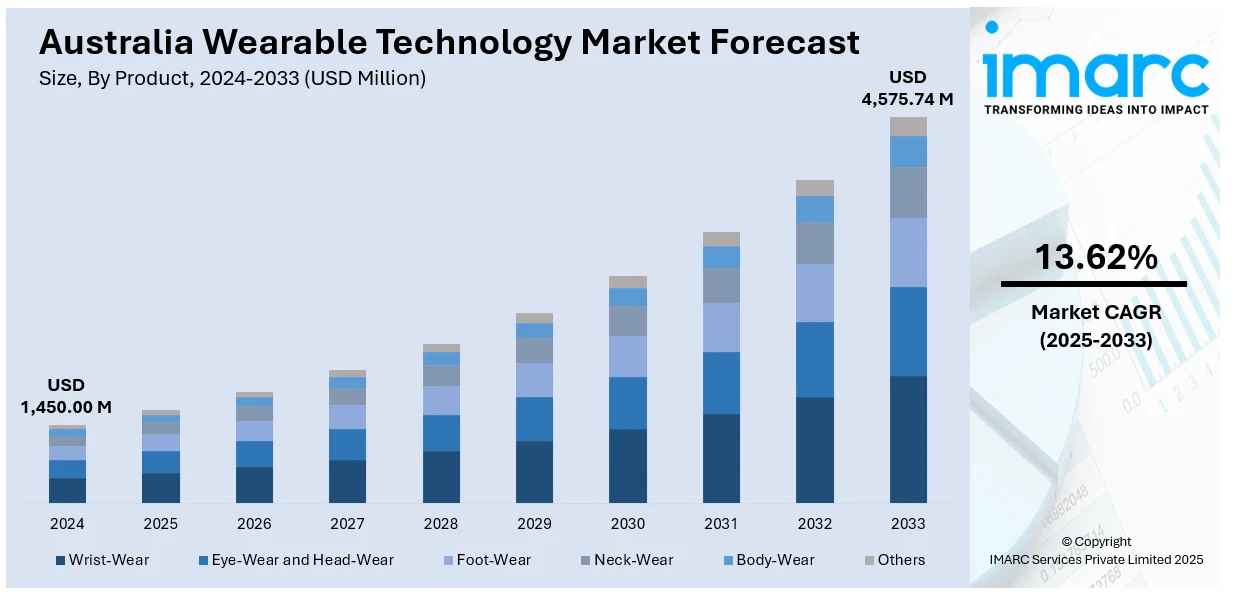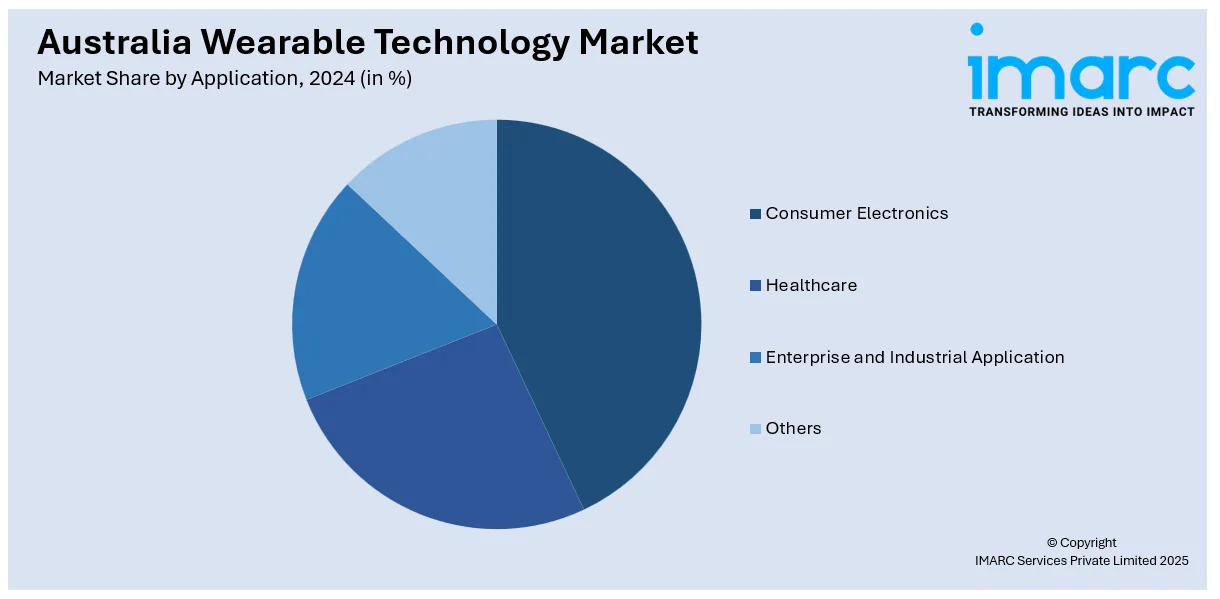
Australia Wearable Technology Market Size, Share, Trends and Forecast by Product, Application, and Region, 2025-2033
Australia Wearable Technology Market Size and Share:
The Australia wearable technology market size reached USD 1,450.00 Million in 2024. Looking forward, IMARC Group expects the market to reach USD 4,575.74 Million by 2033, exhibiting a growth rate (CAGR) of 13.62% during 2025-2033. The market is driven by health monitoring advancements, the integration of IoT, and med wearables. Health and fitness are highly valued by consumers, while demand in smart homes as well as long-distance health monitoring keeps growing. These factors are driving adoption as well as innovation across different spaces, which helps to fuel rising Australia wearable technology market share.
|
Report Attribute
|
Key Statistics
|
|---|---|
|
Base Year
|
2024 |
|
Forecast Years
|
2025-2033
|
|
Historical Years
|
2019-2024
|
| Market Size in 2024 | USD 1,450.00 Million |
| Market Forecast in 2033 | USD 4,575.74 Million |
| Market Growth Rate 2025-2033 | 13.62% |
Australia Wearable Technology Market Trends:
Advances in Health and Fitness Monitoring
Wearable technology has made significant progress in health and fitness tracking in Australia, with products like fitness trackers, smartwatches, and other health-focused wearables becoming increasingly popular. For example, in March 2025, Spacetalk launched Watch Walk AI, incorporating AI-led gait analysis into wearables to identify health risk, as it moved to a subscription-based model for proactive health tracking. Furthermore, these products enable users to monitor a range of health indicators, such as steps, heart rate, sleep, and even stress levels, as part of the larger trend of self-management of health. The growing consumer demand for wellness has pushed the expansion of health-oriented wearables, with individuals looking for ways to meet and sustain fitness targets. Wearables are now more advanced, with the use of sophisticated sensors and analytics to give real-time feedback and accurate analysis. The Australia wearable technology sector is expected to grow significantly, with the health and fitness sector being a major driver of this expansion. As the emphasis shifts toward wellness, wearables have become an integrated part of self-care management, and this trend is likely to persist in the market's outlook.

To get more information on this market, Request Sample
Wearable Integration with IoT and Smart Homes
Wearable technology in Australia is highly being combined with the Internet of Things (IoT) and smart home networks, making the user experience more connected and efficient. This trend involves wearables like smartwatches and fitness bands interacting seamlessly with other smart devices, enabling users to switch on/off various elements of their surroundings. Today, these devices are capable of controlling everything from setting home temperature and lighting levels to integration with health platforms for real-time health monitoring. The amplifies demand for connected devices indicates increased movement towards more connected lifestyles, in which technology drives convenience and efficiency. With the ongoing growth of the IoT ecosystem, wearables are at the forefront of control over smart homes and connected spaces. This trend is likely to drive Australia wearable technology market growth and its share in the next few years. As IoT adoption continues to grow, wearables are poised to further gain traction in the Australian market, driving the overall digital transformation.
Medical Wearables and Remote Health Monitoring
The remote monitoring of health by means of medical wearables represents an upswing in Australia's wearable tech space. Through such wearables, as seen with the availability of ECG monitors, blood pressure cuffs, and glucose sensors, patients have become empowered to monitor their healthcare away from clinic rooms. For instance, in March 2025, WearOptimo revealed data from its clinical trial, showing that its wearable hydration sensor, a minimally invasive patch, performs better than conventional needle-based techniques in measuring dehydration levels. Moreover, with medical professionals devoting more time to preventative treatment and tele-monitoring, the wearables are assisting in lowering the hospital and clinic workload by offering real-time information that can be analyzed and responded to from a distance. This is especially useful for people with chronic conditions who must be monitored all the time but perhaps do not necessarily need to visit in person. There would be increased demand for such wearables as both customers and health caregivers look towards smarter and simpler technologies for maintaining better health. Australian wearable tech trends are certain to witness greater business growth for medical wearables because more people are looking for continual, at-home monitoring by utilizing these types of devices, having a profoundly favorable impact upon market share as a whole and potential.
Australia Wearable Technology Market Segmentation:
IMARC Group provides an analysis of the key trends in each segment of the market, along with forecasts at the country and regional levels for 2025-2033. Our report has categorized the market based on product and application.
Product Insights:
- Wrist-Wear
- Eye-Wear and Head-Wear
- Foot-Wear
- Neck-Wear
- Body-Wear
- Others
The report has provided a detailed breakup and analysis of the market based on the product. This includes wrist-wear, eye-wear and head-wear, foot-wear, neck-wear, body-wear, and others.
Application Insights:

- Consumer Electronics
- Healthcare
- Enterprise and Industrial Application
- Others
A detailed breakup and analysis of the market based on the application have also been provided in the report. This includes consumer electronics, healthcare, enterprise and industrial application, and others.
Regional Insights:
- Australia Capital Territory & New South Wales
- Victoria & Tasmania
- Queensland
- Northern Territory & Southern Australia
- Western Australia
The report has also provided a comprehensive analysis of all the major regional markets, which include Australia Capital Territory & New South Wales, Victoria & Tasmania, Queensland, Northern Territory & Southern Australia, and Western Australia.
Competitive Landscape:
The market research report has also provided a comprehensive analysis of the competitive landscape. Competitive analysis such as market structure, key player positioning, top winning strategies, competitive dashboard, and company evaluation quadrant has been covered in the report. Also, detailed profiles of all major companies have been provided.
Australia Wearable Technology Market News:
- In October 2024, Samsung's Galaxy Ring, introduced in Australia, integrates AI-powered wellness monitoring with cutting-edge sensor technology. It provides sleep, energy, and overall wellness insights via Samsung Health. Supported in various sizes and colors, it features a comfortable, fashionable design for round-the-clock wear, only on Samsung's platform.
Australia Wearable Technology Market Report Coverage:
| Report Features | Details |
|---|---|
| Base Year of the Analysis | 2024 |
| Historical Period | 2019-2024 |
| Forecast Period | 2025-2033 |
| Units | Million USD |
| Scope of the Report |
Exploration of Historical Trends and Market Outlook, Industry Catalysts and Challenges, Segment-Wise Historical and Future Market Assessment:
|
| Products Covered | Wrist-Wear, Eye-Wear and Head-Wear, Foot-Wear, Neck-Wear, Body-Wear, Others |
| Applications Covered | Consumer Electronics, Healthcare, Enterprise and Industrial Application, Others |
| Regions Covered | Australia Capital Territory & New South Wales, Victoria & Tasmania, Queensland, Northern Territory & Southern Australia, Western Australia |
| Customization Scope | 10% Free Customization |
| Post-Sale Analyst Support | 10-12 Weeks |
| Delivery Format | PDF and Excel through Email (We can also provide the editable version of the report in PPT/Word format on special request) |
Key Questions Answered in This Report:
- How has the Australia wearable technology market performed so far and how will it perform in the coming years?
- What is the breakup of the Australia wearable technology market on the basis of product?
- What is the breakup of the Australia wearable technology market on the basis of application?
- What is the breakup of the Australia wearable technology market on the basis of region?
- What are the various stages in the value chain of the Australia wearable technology market?
- What are the key driving factors and challenges in the Australia wearable technology?
- What is the structure of the Australia wearable technology market and who are the key players?
- What is the degree of competition in the Australia wearable technology market?
Key Benefits for Stakeholders:
- IMARC’s industry report offers a comprehensive quantitative analysis of various market segments, historical and current market trends, market forecasts, and dynamics of the Australia wearable technology market from 2019-2033.
- The research report provides the latest information on the market drivers, challenges, and opportunities in the Australia wearable technology market.
- Porter's five forces analysis assist stakeholders in assessing the impact of new entrants, competitive rivalry, supplier power, buyer power, and the threat of substitution. It helps stakeholders to analyze the level of competition within the Australia wearable technology industry and its attractiveness.
- Competitive landscape allows stakeholders to understand their competitive environment and provides an insight into the current positions of key players in the market.
Need more help?
- Speak to our experienced analysts for insights on the current market scenarios.
- Include additional segments and countries to customize the report as per your requirement.
- Gain an unparalleled competitive advantage in your domain by understanding how to utilize the report and positively impacting your operations and revenue.
- For further assistance, please connect with our analysts.
 Request Customization
Request Customization
 Speak to an Analyst
Speak to an Analyst
 Request Brochure
Request Brochure
 Inquire Before Buying
Inquire Before Buying




.webp)




.webp)












